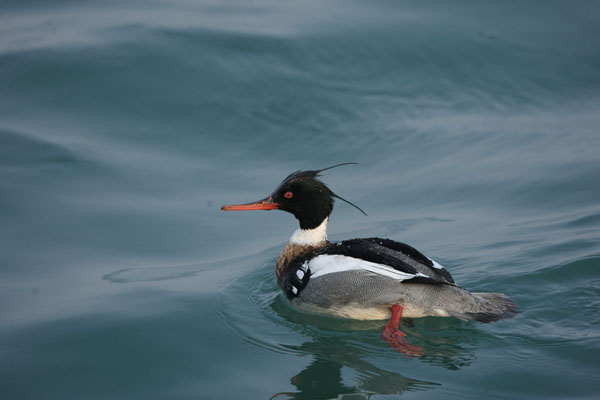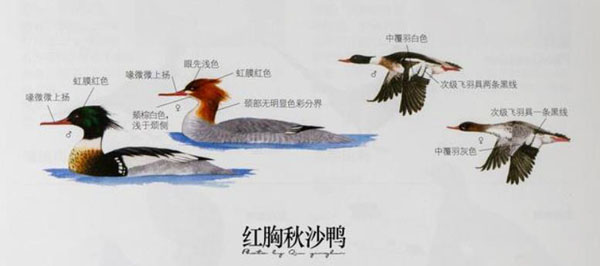Mergus serrator
IUCN
LCBasic Information
Scientific classification
- name:Mergus serrator
- Scientific Name:Black-headed Duck, Brown-headed Duck,Mergus serrator,Red-breasted Merganser
- Outline:Waterfowl
- Family:Anseriformes Anatidae Merganser
Vital signs
- length:53cm
- Weight:600-1100g
- lifetime:No verification information
Feature
The most common merganser in China
Distribution and Habitat
In China, it breeds in the northern part of Heilongjiang, migrates through most of China, and winters in the southeastern coastal areas. Winter migrants rarely come to Taiwan Island. Abroad, it breeds in the extreme north of the Holarctic, winters in the coastal waters in the southern part of the distribution area, and occasionally has inland records.
Red-breasted mergansers live in tundra swamps, rivers and lakes during the breeding season. In the non-breeding season, they prefer saltwater waters such as coastal coasts, estuaries and shallow bays compared to other mergansers.
Appearance
The male has a dark green head and upper neck, black upper back, gray waist and tail feathers, white lower body, gray worm-like markings on both flanks, and is different from other mergansers in that the chest is dark brown, and the crest feathers behind the occipital are long and obviously forked. The female has a brown head, white eye rings and a black upper and white lower eyelid, and a grayish white chin, throat and front neck. The iris is red, the beak is narrow and slightly upturned with a hook at the tip, dark red, dark brown at the tip, and orange-red feet.
Details
Red-breasted mergansers are medium-sized fish-eating ducks with long, thin, hooked beaks that prey on fish. The silky crest feathers are long and pointed. The breeding season of Red-breasted mergansers is from May to July. They usually form pairs during migration in late winter and spring, and some pairs form pairs after arriving at the breeding grounds. They nest in bushes or grass on the ground near the shores of lakes, rivers, etc., or under rocks by the river and in rock crevices. Sometimes they also nest in tree holes and pits. The nest is usually padded with a little dead grass and a lot of down feathers.

Red-breasted Mergansers often move in small groups. They often move and forage in the intertidal zone near the coast and the rocks near it. They spend almost the entire day in the water and rarely come to the shore to move. When swimming, they often immerse their heads in the water to look for food in the water and dive frequently. When resting, they often float on the water. They hold their heads high. Their necks are stretched straight. Sometimes they also rest on the shore. They are also good at walking on land. When diving, it leaps up and then turns over and dives back into the water, just like other mergansers. Each dive lasts 20-30 seconds. It flies fast and straight. When taking off, it needs to flap its wings rapidly on the water surface for a while before it can fly, which seems a bit laborious and clumsy. It is timid and alert. Its call is quite quiet. When the male is in heat, it makes a variety of soft, cat-like meowing sounds. The female makes a panting sound when in heat and flying.

Red-breasted Mergansers mainly forage by diving, but sometimes they also dive their heads directly into the water in shallow waters near the water to forage. When foraging, they often swim in small groups, diving while foraging, and sometimes they disperse into 2-3 or single individuals to forage. The main food is small fish, and they also eat other aquatic animals such as aquatic insects, insect larvae, crustaceans, and mollusks. Occasionally, they also eat a small amount of plant food.
The difference between the red-breasted merganser and the Chinese merganser is that the breast is brown and the stripes are dark.
The difference between the red-breasted merganser and the common merganser is that the breast is dark and the crest is longer.








